Nonlinear Blind Source Separation and Fault Feature Extraction Method for Mining Machine Diagnosis
Abstract
:Featured Application
Abstract
1. Introduction
2. The Proposed Method
2.1. Wavelet-Nonlinear ICA Model
2.2. Fault Feaure Extraction and Identification
3. Results
4. Discussions
5. Conclusions
Author Contributions
Funding
Acknowledgments
Conflicts of Interest
References
- Miriam, A.; Anna, G.; Daniela, M.; Gabriel, F.; Vieroslav, M. Using logistic regression in tracing the significance of rubber–textile conveyor belt damage. Wear 2014, 318, 145–152. [Google Scholar]
- Glowacz, A. Fault diagnosis of single-phase induction motor based on acoustic signals. Mech. Syst. Signal Process. 2019, 117, 65–80. [Google Scholar] [CrossRef]
- Li, Z.; Jiang, Y.; Guo, Q.; Hu, C.; Peng, Z. Multi-dimensional variational mode decomposition for bearing-crack detection in wind turbines with large driving-speed variations. Renew. Energy 2018, 116, 55–73. [Google Scholar] [CrossRef]
- Glowacz, A. Fault Detection of Electric Impact Drills and Coffee Grinders Using Acoustic Signals. Sensors 2019, 2, 269. [Google Scholar] [CrossRef] [PubMed]
- Liu, G.; Wang, M.; Wang, A.; Wang, S.; Yang, T.; Malekian, R.; Li, Z. Research on flow field perception based on artificial lateral line sensor system. Sensors 2018, 18, 838. [Google Scholar] [CrossRef] [PubMed]
- Taghizadeh-Alisaraei, A.; Mahdavian, A. Fault detection of injectors in diesel engines using vibration time-frequency analysis. Appl. Acoust. 2019, 143, 48–58. [Google Scholar] [CrossRef]
- Li, Z.; Jiang, Y.; Hu, C.; Peng, Z. Difference equation based empirical mode decomposition with application to separation enhancement of multi-fault vibration signals. J. Differ. Equ. Appl. 2017, 23, 457–467. [Google Scholar] [CrossRef]
- Zheng, J.D.; Pan, H.Y.; Cheng, J.S. Rolling bearing fault detection and diagnosis based on composite multiscale fuzzy entropy and ensemble support vector machines. Mech. Syst. Signal Process. 2017, 85, 746–759. [Google Scholar] [CrossRef]
- Pan, N.; Wu, X.; Chi, Y.L.; Liu, X.Q.; Liu, C. Mechanical equipment condition monitoring and fault diagnosis based on frequency-domain blind deconvolution. J. Vib. Shock 2012, 31, 34–41. [Google Scholar]
- Xing, W.U.; Chen, J.B.; Wu, J. Using blind source separation to recover the mechanical fault feature. J. Mech. Strength 2002, 4, 3. [Google Scholar]
- Jiao, W.D.; Yang, S.X.; Wu, Z.T. A method of blind source separation for rotating machinery based on estimation of the number of sources. China Mech. Eng. 2003, 14, 1. [Google Scholar]
- Li, Z.; Jiang, Y.; Hu, C.; Peng, Z. Recent progress on decoupling diagnosis of hybrid failures in gear transmission systems using vibration sensor signal: A review. Measurement 2016, 90, 4–19. [Google Scholar] [CrossRef]
- Hyvärinen, A.; Patrik, O.H.; Mika, I. Topographic independent component analysis. Neural Comput. 2001, 13, 1527–1558. [Google Scholar] [CrossRef]
- Tan, Y.; Wang, J.; Zuradam, M. Nonlinear blind source separation using a radial basis function network. IEEE Trans. Neural Netw. 2001, 12, 124–134. [Google Scholar]
- Swaim, M.; Rutuparna, P.; Prithviraj, K. A Comparative Study of Infomax, Extended Infomax and Multi-User Kurtosis Algorithms for Blind Source Separation. Int. J. Rough Sets Data Anal. 2019, 6, 1–17. [Google Scholar] [CrossRef]
- Li, Z.; Yan, X.; Wang, X.; Peng, Z. Detection of gear cracks in a complex gearbox of wind turbines using supervised bounded component analysis of vibration signals collected from multi-channel sensors. J. Sound Vib. 2016, 371, 406–433. [Google Scholar] [CrossRef]
- Fantinato, D.G.; Duarte, L.T.; Deville, Y.; Attux, R.; Jutten, C.; Neves, A. A second-order statistics method for blind source separation in post-nonlinear mixtures. Signal Process. 2019, 155, 63–72. [Google Scholar] [CrossRef]
- Li, J.; Zhang, H.; Wang, P. Blind separation of temporally correlated noncircular sources using complex matrix joint diagonalization. Pattern Recognit. 2019, 87, 285–295. [Google Scholar] [CrossRef]
- He, P.; She, T.; Li, W.; Yuan, W. Single channel blind source separation on the instantaneous mixed signal of multiple dynamic sources. Mech. Syst. Signal Process. 2018, 113, 22–35. [Google Scholar] [CrossRef]
- Li, Z.; Peng, Z. A new nonlinear blind source separation method with chaos indicators for decoupling diagnosis of hybrid failures: A marine propulsion gearbox case with a large speed variation. Chaos Solitions Fractal 2016, 89, 27–39. [Google Scholar] [CrossRef]
- Pajunen, P.; Hyvarinen, A.; Karhunen, J. Nonliner blind source separation by self-organizing maps. In Proceedings of the International Conference on Neural Information Processing, Hong Kong, China, 24–27 September 1996; Volume 2, pp. 1207–1210. [Google Scholar]
- Burel, G. Blind separation of sources: A nonlinear neural algorithm. Neural Netw. 1992, 5, 937–947. [Google Scholar] [CrossRef]
- Xie, S.; Xie, Y.; Huang, T.; Gui, W.; Yang, C. Generalized Predictive Control for Industrial Processes Based on Neuron Adaptive Splitting and Merging RBF Neural Network. Neural Networks. IEEE Trans. Ind. Eelctron. 2019, 66, 1192–1202. [Google Scholar] [CrossRef]
- He, H.; Tan, Y.; Xing, J. Unsupervised classification of 12-lead ECG signals using wavelet tensor decomposition and two-dimensional Gaussian spectral clustering. Knowl.-Based Syst. 2019, 163, 392–403. [Google Scholar] [CrossRef]
- Wang, Y.; He, Z.; Zi, Y. Enhancement of signal denoising and multiple fault signatures detecting in rotating machinery using dual-tree complex wavelet transform. Mech. Syst. Signal Process. 2010, 24, 119–137. [Google Scholar] [CrossRef]
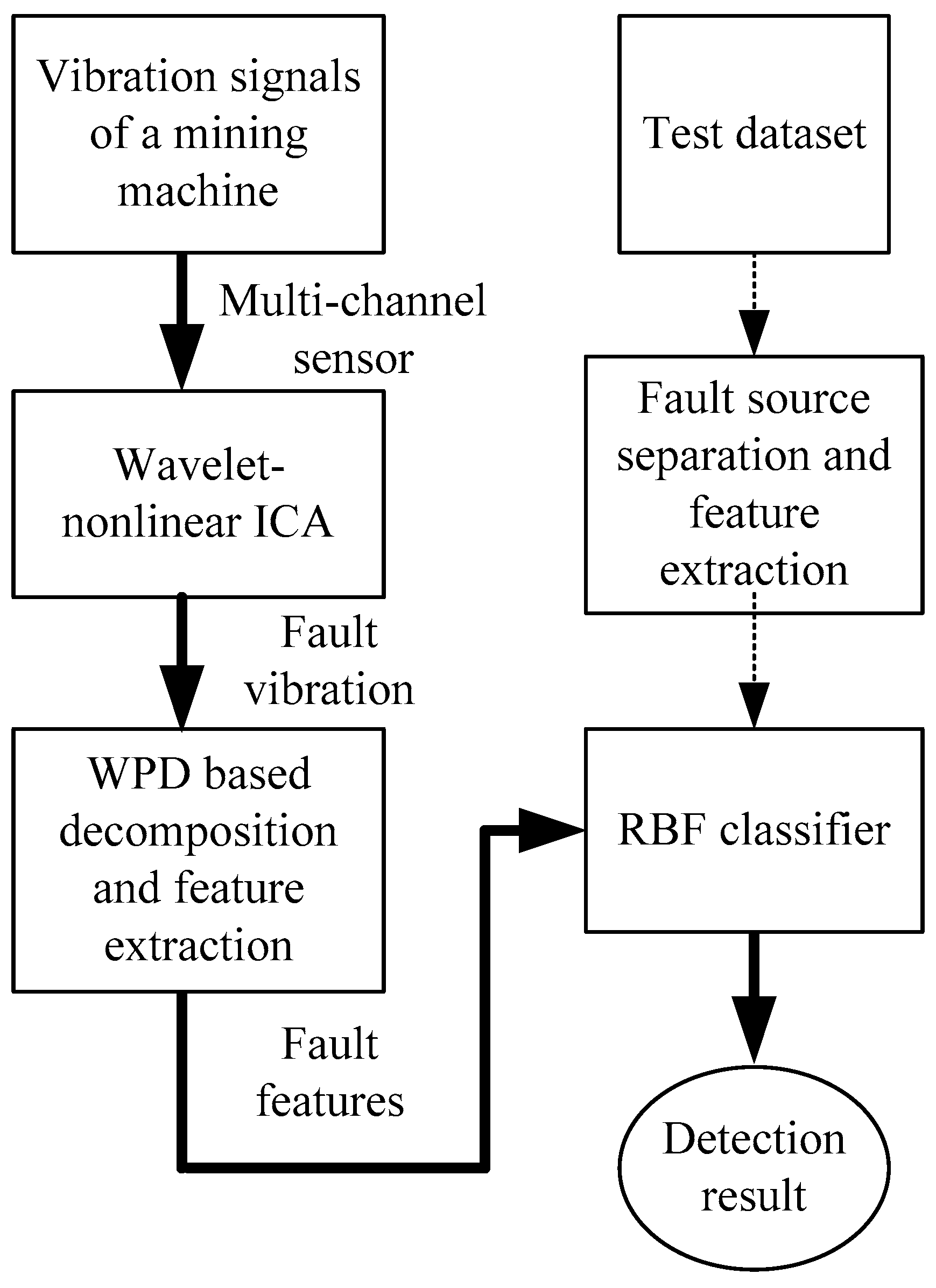

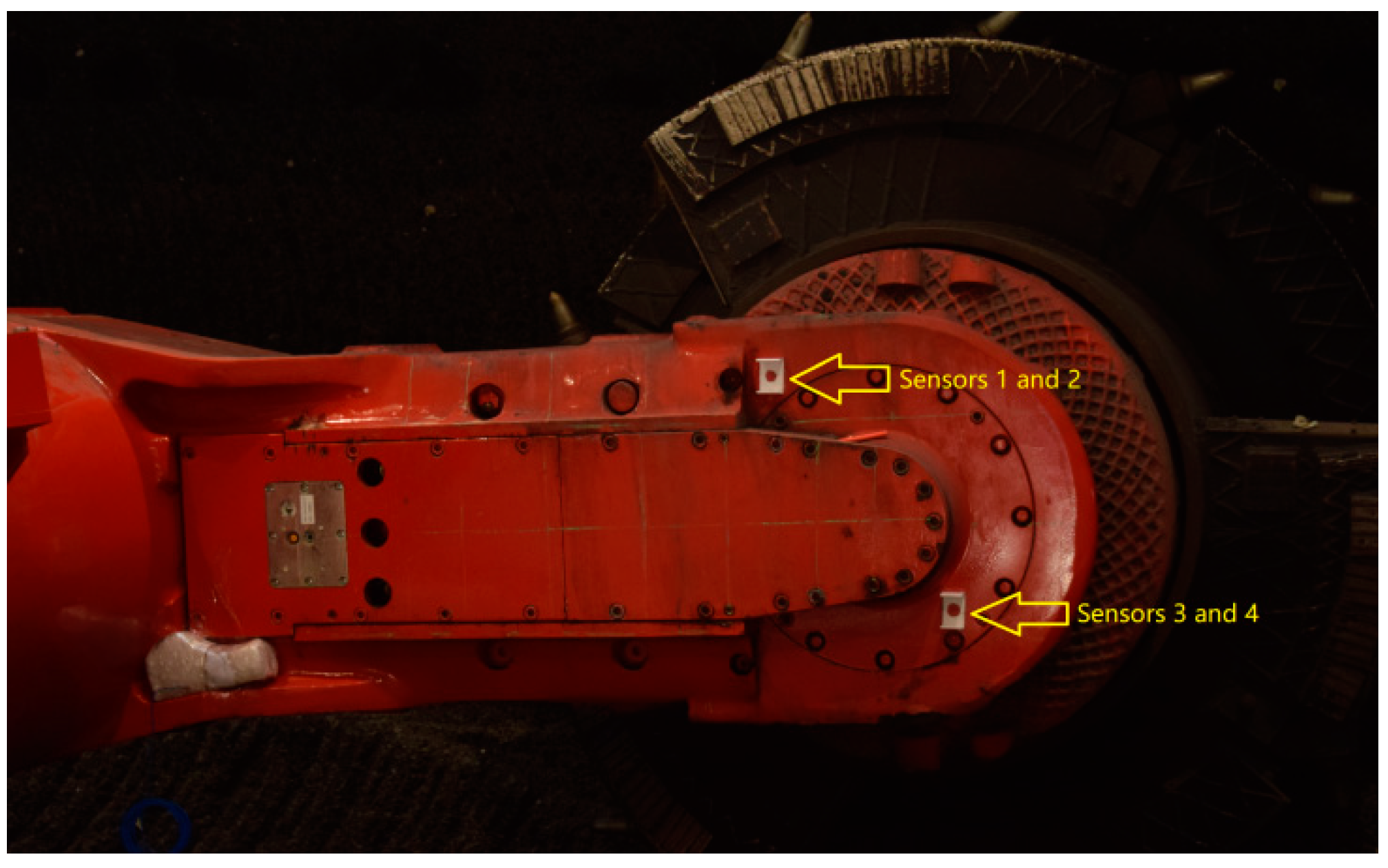
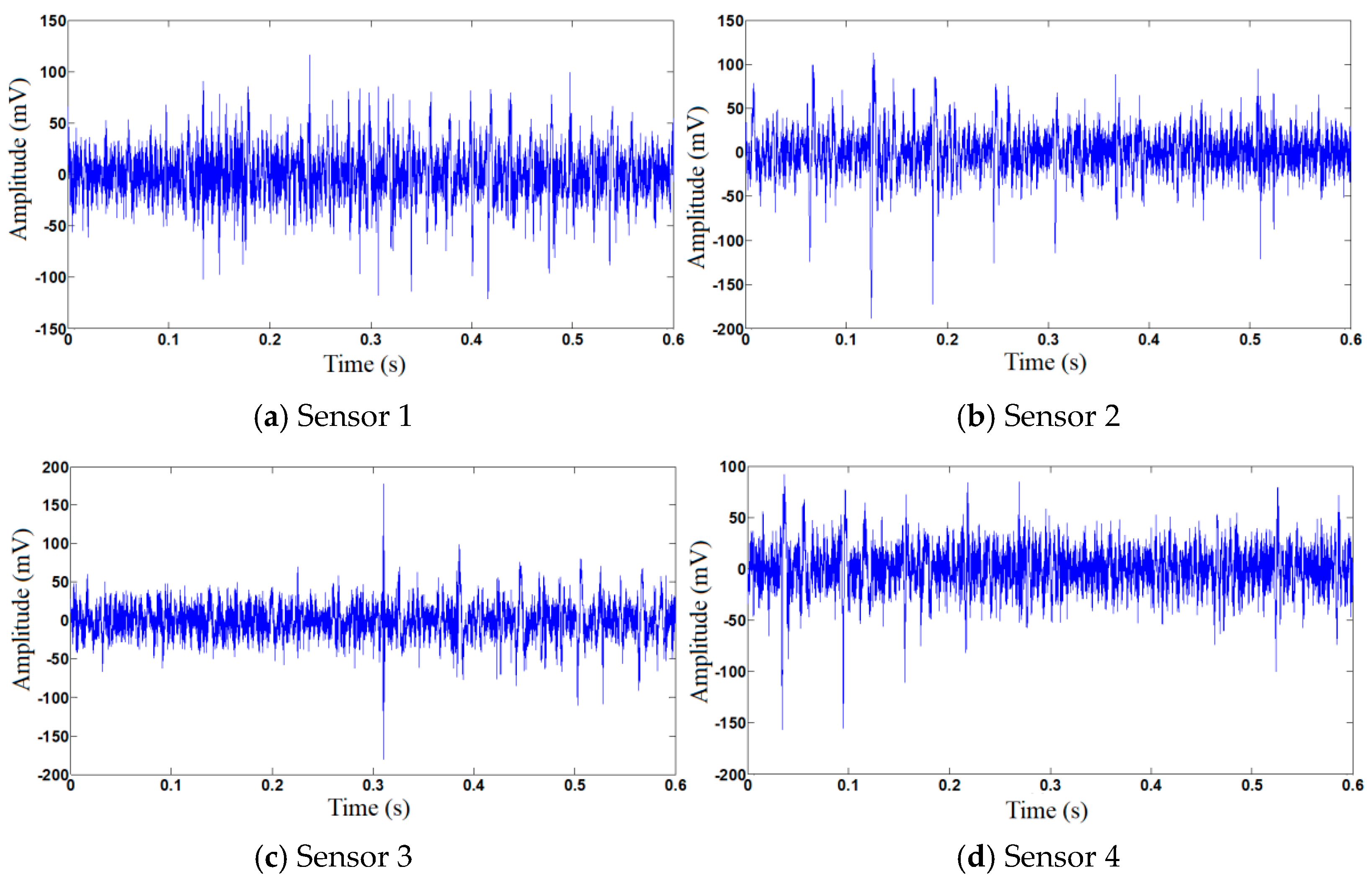
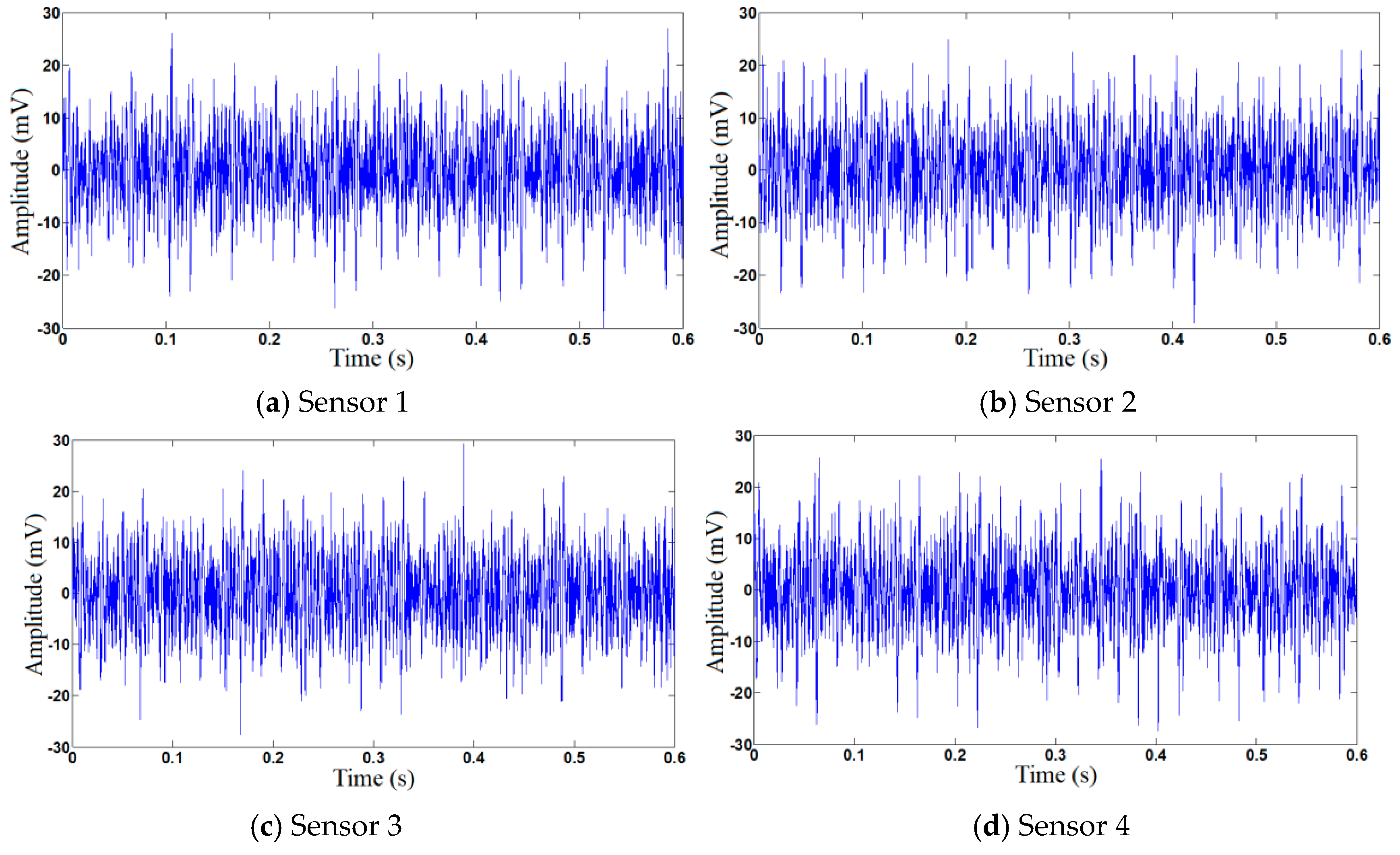

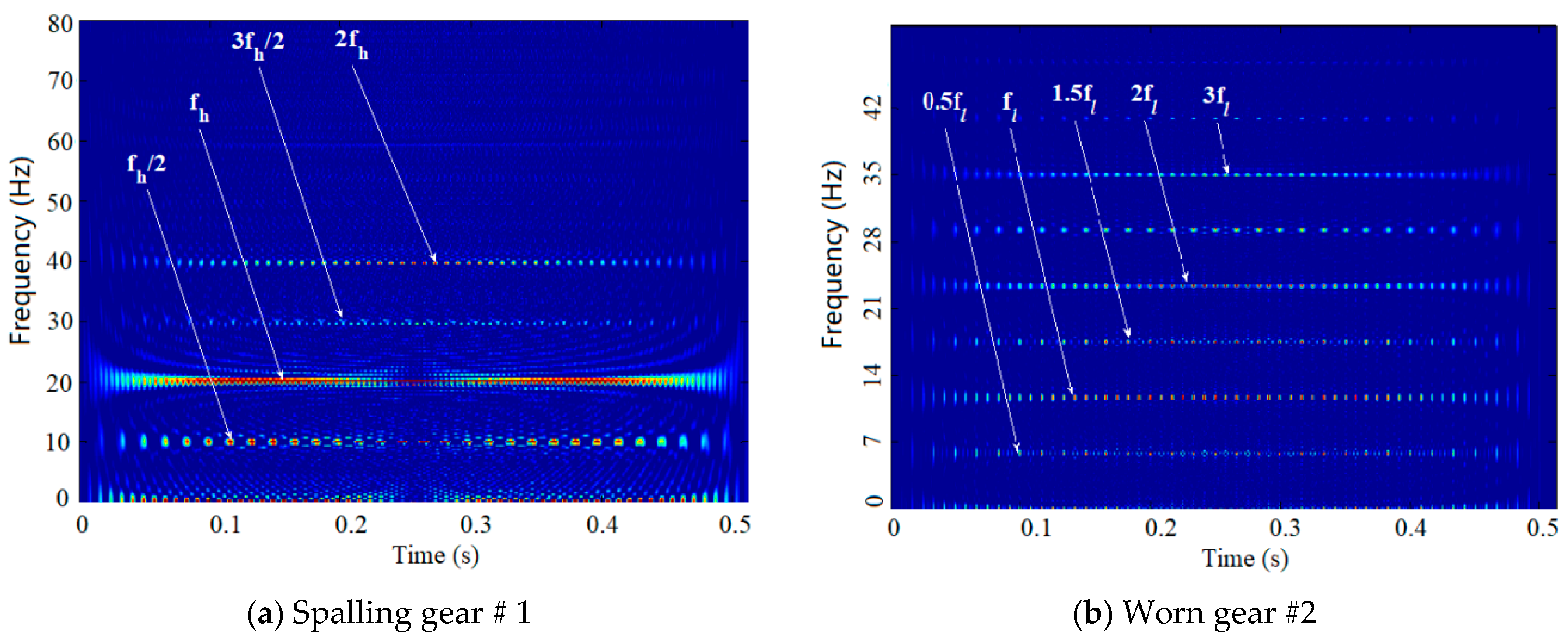
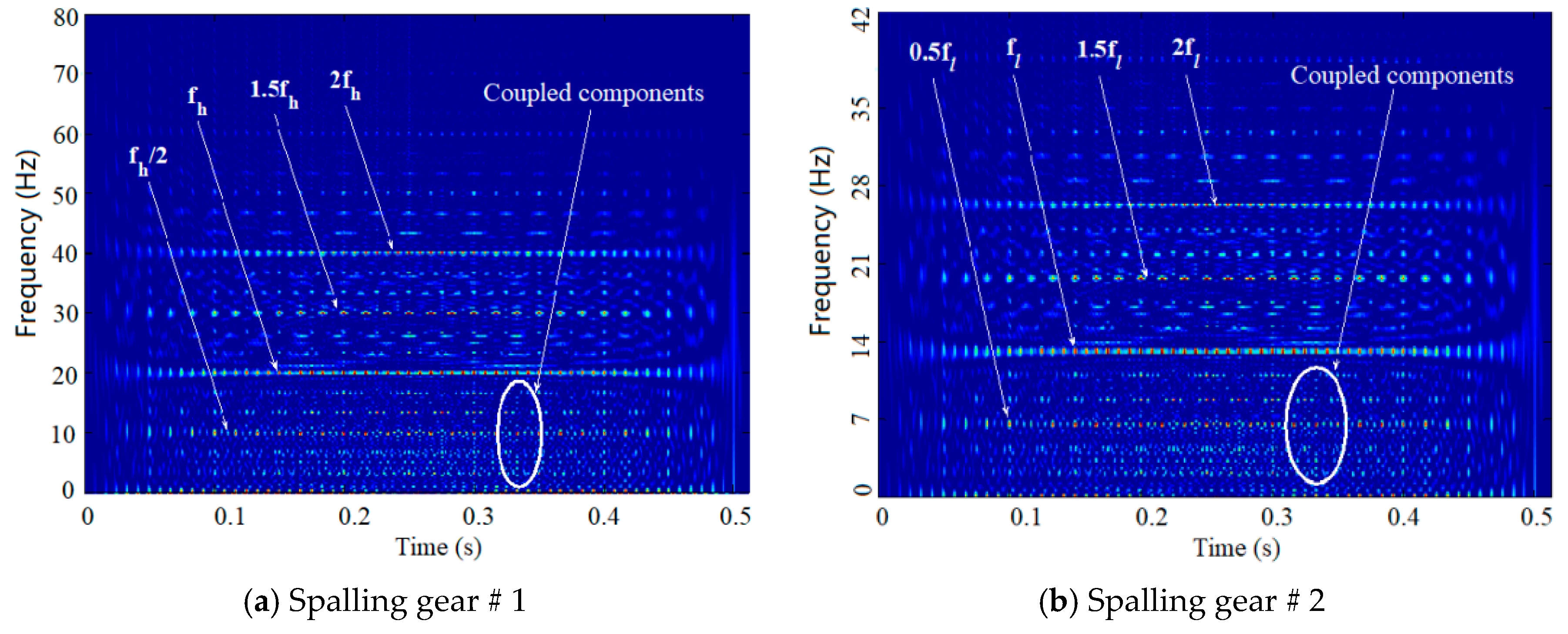
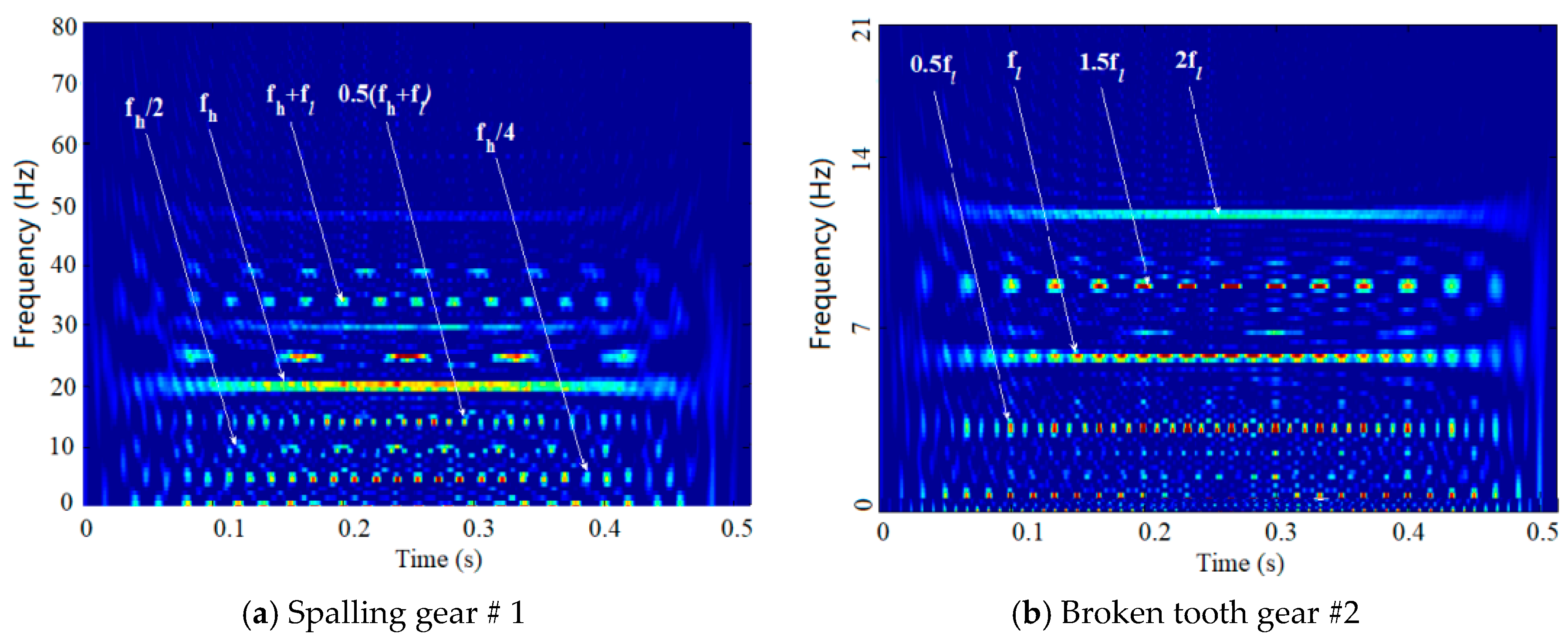
| Step: | Implementation |
|---|---|
| 1. | Training: Establish a fault detection model |
| 1.1 | Measure multi-channel vibration signals of the mining machine |
| 1.2 | Separate the fault vibration source using wavelet-nonlinear ICA |
| 1.3 | Extract fault features based on wavelet package decomposition (WPD) |
| 1.4 | Train a radial basis function neural network (RBFNN) classifier using the features |
| 2. | Testing: Validate the trained model using test datasets |
| 2.1 | Extract fault features using the wavelet-nonlinear ICA and WPD preprocessing |
| 2.2 | Identify the fault patterns via the trained RBFNN |
| Condition | Method | RBF output | Truth | Result | ||
|---|---|---|---|---|---|---|
| Spalling gear #1 + worn gear #2 | FastICA | 0.4541 | 0.3375 | 0.8183 | [0 0 1] | Correct |
| Wavelet-FastICA | 0.2145 | 0.1536 | 0.9211 | [0 0 1] | Correct | |
| Nonlinear ICA | 0.3125 | 0.3127 | 0.8843 | [0 0 1] | Correct | |
| Wavelet-Nonlinear ICA | 0.0883 | 0.1036 | 0.9765 | [0 0 1] | Correct | |
| Spalling gear #1 + spalling gear #2 | FastICA | 0.7362 | 1.0053 | 0.4381 | [0 1 0] | Incorrect |
| Wavelet-FastICA | 0.4809 | 1.6476 | 0.5147 | [0 1 0] | Incorrect | |
| Nonlinear ICA | 0.4809 | 0.5033 | 1.6476 | [0 1 0] | Incorrect | |
| Wavelet-Nonlinear ICA | 0.3842 | 1.1481 | 0.4238 | [0 1 0] | Correct | |
| Spalling gear #1 + broken gear #2 | FastICA | 0.7862 | 0.1154 | 0.7124 | [1 0 0] | Incorrect |
| Wavelet-FastICA | 1.4429 | 0.4154 | 0.4124 | [1 0 0] | Incorrect | |
| Nonlinear ICA | 1.3009 | 0.4342 | 0.4752 | [1 0 0] | Correct | |
| Wavelet-Nonlinear ICA | 1.2135 | 0.1399 | 0.3654 | [1 0 0] | Correct | |
| Wavelet-Nonlinear ICA | Nonlinear ICA | Wavelet-FastICA | FastICA | ||||
|---|---|---|---|---|---|---|---|
| Correctness | Misdiagnosis | Correctness | Misdiagnosis | Correctness | Misdiagnosis | Correctness | Misdiagnosis |
| 93.3% | 2.7% | 87.8% | 4.3% | 88.9% | 3.7% | 82.2% | 6.7% |
| Mother Wavelet | Correctness |
|---|---|
| db10 | 93.3% |
| db17 | 91.1% |
| sym5 | 91.1% |
| Sym7 | 93.3% |
| haar | 88.9% |
| bior3.3 | 91.1% |
© 2019 by the authors. Licensee MDPI, Basel, Switzerland. This article is an open access article distributed under the terms and conditions of the Creative Commons Attribution (CC BY) license (http://creativecommons.org/licenses/by/4.0/).
Share and Cite
Ding, H.; Wang, Y.; Yang, Z.; Pfeiffer, O. Nonlinear Blind Source Separation and Fault Feature Extraction Method for Mining Machine Diagnosis. Appl. Sci. 2019, 9, 1852. https://doi.org/10.3390/app9091852
Ding H, Wang Y, Yang Z, Pfeiffer O. Nonlinear Blind Source Separation and Fault Feature Extraction Method for Mining Machine Diagnosis. Applied Sciences. 2019; 9(9):1852. https://doi.org/10.3390/app9091852
Chicago/Turabian StyleDing, Hua, Yiliang Wang, Zhaojian Yang, and Olivia Pfeiffer. 2019. "Nonlinear Blind Source Separation and Fault Feature Extraction Method for Mining Machine Diagnosis" Applied Sciences 9, no. 9: 1852. https://doi.org/10.3390/app9091852





